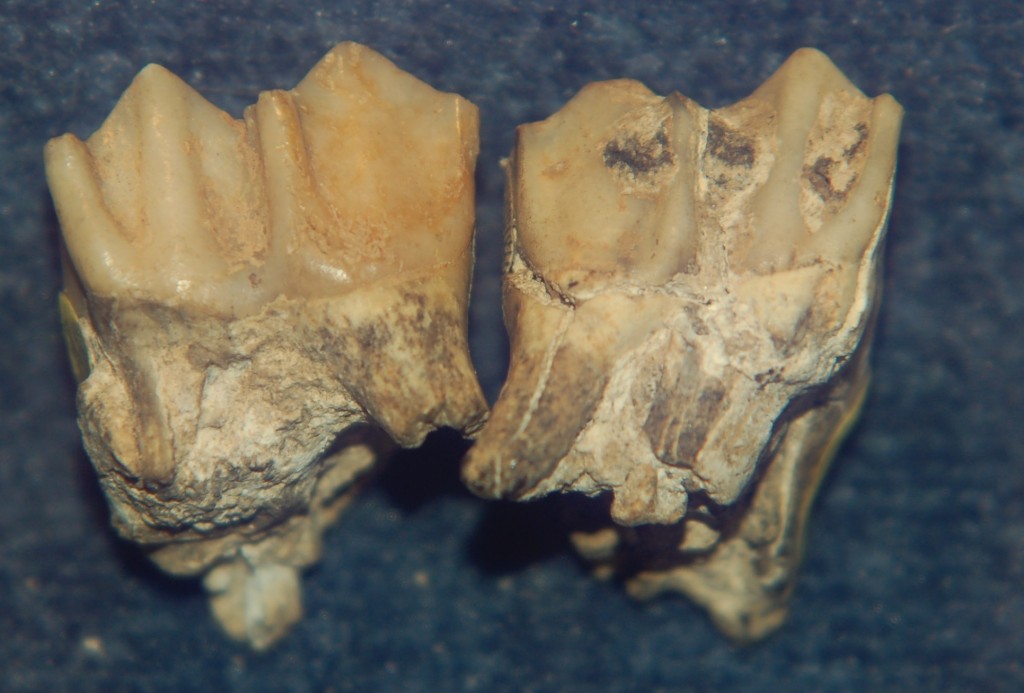
Mesowear analysis was developed by Fortelious and Solounias in 2000 and measures attrition and abrasion on selenodont ungulate upper molars. Mesowear analysis measures the abrasion of upper molars on selenodont ungulates and has been shown to be a reliable proxy for diet in both extant and extinct species, specifically in distinguishing the degree of browse vs. graze in the diet. Mesowear is a function of dental wear over ca. the last 6 months of an individual’s lifetime and is independent of the effects of seasonality, migration patterns or stochastic effects, such as the effects of the individual’s last meal, which is common in other paleodietary methods. Mesowear measures two variables, occlusal relief and occlusal shape, on the paracone of upper M1/M2 of selenodont ungulates. Occlusal relief has two variables: high and low, which are dependent on the height of the cusps above the valley between them. Occlusal shape has three variables: sharp, round and blunt.
In our lab we are working on using cervid and bovid mesowear as a paleoecological proxy in Mediterranean environments.
Publications and conference presentations:
- Presley J., and Belmaker, M., (2015). Ecology in space and time: Utilizing Geographic Information Systems to reconstructs paleoenvironments from tooth wear patterns of gazelles in Israel. Paper submitted to the 49th GSA South Central meeting. Stillwater, OK.
- Clardy Kelsey and Belmaker, M. (2013). Development of a Paleoclimatic Predictive Model Based on Gazella gazella Mesowear of the Last Glacial in the Levant. Paper presented at the Annual meeting of the Society for American Archaeology. Honolulu. Hawaii. Podium presentation by M. Belmaker.
- Hack, Kelsey A., and Belmaker M.,. (2012) Development of a Paleoclimatic Model through GlS Applications Based on Mesowear Analysis of Gazella gazella. Paper presented at the Archaeological Sciences of the America (ASAS) Symposium. Nashville, TN
- Belmaker, M. and Curran, S. (2010). Paleolocomotion and paleodietary studies of the cervid guild in the Lower Paleolithic site of ‘Ubeidiya, Israel: Implications of early Homo landscape use in mid latitudes. Paper presented at the Annual meeting of the Society for American Archaeology. St. Louis. Mo.
- Belmaker, M. (2008). Did a decrease in environmental productivity contribute to the extinction of the Levantine Neanderthals? Evidence from mesowear analysis of ungulate diet during MIS 4-3 in the Levant. Paper presented at the 20th Annual meeting the Israel Prehistoric Society. Jerusalem, Israel
- Belmaker, M. (2008). Mesowear analysis of ungulate diet during MIS 4-3 in the Levant: Implica- tions for the extinctions of the Neanderthals. American Journal of Physical Anthropology. Special Issue: Program of the 77th Annual Meeting of the American Association of Physical Anthropologists 135 (S46) pp. 66-67.
- Belmaker, M. (2008). Paleodietary analysis of medium-sized cervids in ‘Ubeidiya, Israel: Evidence for Mediterranean oak woodland habitat in the early Pleistocene of the Jordan Valley and its bearing on climatic hypotheses of ‘Out of Africa I’. Paleoanthropology Society Meetings Abstracts, Vancouver, BC, April 2008 PaleoAnthropology 2008:A3.
- Belmaker, M., Nelson, S.V., Morgan, M.E., Barry, J. and Badgley, C. (2007). Mesowear analysis of ungulates in the Middle to Late Miocene of the Siwaliks, Pakistan: Dietary and paleoenvironmental implications. Journal of Vertebrate Paleontology, Supplement to the online Journal of Vertebrate Paleontology 27 (supplement to number 3) pp. 46A.
- Belmaker, M., Nelson, S.V., Morgan, M.E., Flynn L.J., Barry, J.C., Pilbeam, D. and Badgley, C. (2007). Dietary reconstructions of the Middle and Late Miocene ungulate communities in the Siwaliks, Pakistan. Paleoanthropology Society Meetings Abstracts, Philadelphia, PA, April 2007 PaleoAnthropology 2007:A2-A3.